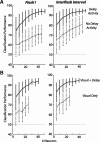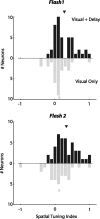Selection and maintenance of spatial information by frontal eye field neurons
- PMID: 20016076
- PMCID: PMC3351279
- DOI: 10.1523/JNEUROSCI.4465-09.2009
Selection and maintenance of spatial information by frontal eye field neurons
Abstract
Voluntary attention is often allocated according to internally maintained goals. Recent evidence indicates that the frontal eye field (FEF) participates in the deployment of spatial attention, even in the absence of saccadic eye movements. In addition, many FEF neurons maintain persistent representations of impending saccades. However, the role of persistent activity in the general maintenance of spatial information, and its relationship to spatial attention, has not been explored. We recorded the responses of single FEF neurons in monkeys trained to remember cued locations in order to detect changes in targets embedded among distracters in a task that did not involve saccades. We found that FEF neurons persistently encoded the cued location throughout the trial during the delay period, when no visual stimuli were present, and during visual discrimination. Furthermore, FEF activity reliably predicted whether monkeys would detect the target change. Population analyses revealed that FEF neurons with persistent activity were more effective at selecting the target from among distracters than neurons lacking persistent activity. These results demonstrate that FEF neurons maintain spatial information in the absence of saccade preparation and suggest that this maintenance contributes to the selection of relevant visual stimuli.
Figures






References
-
- Abbott LF, Dayan P. The effect of correlated variability on the accuracy of a population code. Neural Comput. 1999;11:91–101. - PubMed
-
- Armstrong KM, Fitzgerald JK, Moore T. Changes in visual receptive fields with microstimulation of frontal cortex. Neuron. 2006;50:791–798. - PubMed
-
- Awh E, Anllo-Vento L, Hillyard SA. The role of spatial selective attention in working memory for locations: evidence from event-related potentials. J Cogn Neurosci. 2000;12:840–847. - PubMed
-
- Awh E, Armstrong KM, Moore T. Visual and oculomotor selection: links, causes and implications for spatial attention. Trends Cogn Sci. 2006;10:124–130. - PubMed
Publication types
MeSH terms
Grants and funding
LinkOut - more resources
Full Text Sources
